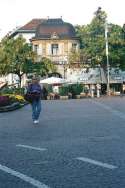 Bozen
Bozen Bozen
Bozen


 |
|
The city of Bolzano lies at 265 m above sea level at the southern end of the the Brenner Pass (Paseo Brennero).
At its highest point Brenner Pass is 4,495 ft (1,370 m) above sea level and is the lowest and most accessible from
the Alpine Passes. The pass connects Bolzano on its souothern end with Innsbruck on its northern end.
Bolzano is the capital of the autonomous Italian province of South Tyrol (Südtirol in German, Alto Adige in Italian). The 98000 inhabitants are split approximately 70/30 between Italians and Germans. The city is surrounded by splendid mountains, The Dolomites. It is situated on one of a major shipping route connecting the north of Europe with Italy. This route, the Brenner Pass has been used already by the Romans. Bolzano was founded as a Roman fort around 15 BC by Drusus, the adoptive son of Emperor Augustus. Drusus subdued the whole territory of the Adige and Isarco valleys and constructed in the Bolzano area a bridge (Pons Drusi) and a road post. The precise location of this post - probably small and not very significant - is not well known. After the fall of the Roman Empire the region was invaded several times by the Goths, the Franks, the Lombards and the Bavarians. In the 11th century, Emperor Conrad II granted the land to the Bishop of Trento Ulderico II. The Bishop expropriated a vineyard belonging to the monastery of Tegernsee and promoted the foundation of the first urban nucleus, corresponding to today's Portici, a favourite street for commercial activity (street junction for the communication between north and south). Most of the inner city was constructed during the 12th and 13th century: the city walls and a moat system were built and it obtained municipal rights. In 1277 it passed under the rule of the Counts of Tyrol and in 1366 to the Habsburgs, thereby increasing its commercial inclination and expanding into the zone of today's town centre. The medieval urban structure remained almost intact until the middle of the 18th century, when the town architect Sebastian Altman from Munich was entrusted with the drawing up of a project for the construction of a district of the new city. At the end of the First World War, with the St. Germain Peace Treaty (1919), the Italian-Austrian border was drawn at the Brenner Pass, resulting in the annexation of the southern part of Tyrol to Italy. In the 1930s Mussolini transfored the city into an industrial center, paving a new but historically foreign path for the city. Therefore, the city underwent a visible and strong change in the social tissue and in its appearance. New vast agricultural areas were expropriated to build big factories (Lancia, Acciaierie (Steel) industries, Montecatini), but also streets and new districts for the blue collar workerss and officials. In the second half of the 1930s the Nazis started to plot a "solution" for transferring the local German-speaking population into the territories Galicia, Bohemia and Slesia occupied by Hitler in Czechoslovakia. During the Second World War, Bolzano saw itself housing a transition camp where many deported Italian Jews waited for their ultimate destiny in the concentration camps of the Third Reich. Just like the Romans before them, the Allied armed forces in the Second World War saw the strategic importance of the Brenner Pass. The industrialization of Bolzano carried out by Mussolini in the 1930 meant that the city \ itself was bombed heavily during the war. The Brenner Pass became a target on November 6 1944 during Operation Bingo carried out by the 57th. Bomb Wing of the United States Air Force. The goal of the mission was to stop the flow of German goods coming to the fighting front by closing off the Brenner Pass. The Allied air forces also used used the relatively low-lying pass as an ingress route across the Alps against targets in Austria and Germany. Luckily, the charming medieval center of the city survived the mess of the Second World War relatively untouched. Today, architecturally and culturally, Bolzano is a town of two faces: strong un-Italian for those travelling from the south, and Mediterranean for those travelling from the north. Most speak both German and Italian, but consider themselves neither. In fact, crossing the border from Austria to Italy, the sign on the side of the highway reads not "Welcome to Italy", but "Welcome to South Tyrol". The pizza and excellent local red wines are distinctly Italian, but the beers (including very un-Italian Weissbier (unfiltered yeast beer) come from Munich. Various mountain ridges and plateaus surround the town: the Ritten plateau with its famous earth pyramids and delightful inns, Jenesien on the Tschöggelberg plateau and the Kohlern mountain -all are just a short excursion from the town and have been popular for centuries as holiday resorts for the inhabitants of Bozen. Also nearby is the Sarntal valley, famous not only for its costumes but also for its intricate woodwork and for the old custom of "Klöckeln"- driving away the evil spirits at the winter solstice Sources:
|
Continue your virtual visit on these websites
Live camera view of the Dolomites
Bolzano official site
Bolzano.net
South Tyrol official site
Windows on Italy - the Regions
Bolzano city map
Place to stay? Hotel Figl on
Piazza del Grano
Place to hang out? Exil Lounge Cafe, Piazza del Grano
Photographs (c) 2001 Radim and Lisa Kolarsky
Last updated October 28, 2001